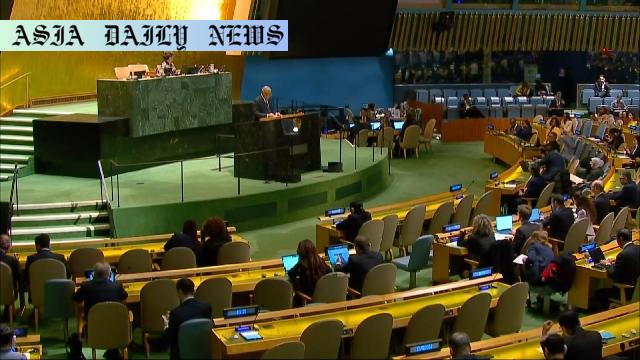UN Resolution highlights divisions over Ukraine conflict on the third anniversary of Russia’s invasion.
UN General Assembly adopts resolution against Russia’s invasion with 93 countries in favor.
The US opposed the resolution, instead submitting its own draft for conflict resolution.
An amendment to the US resolution included criticism of Russia and was adopted by majority.
The resolution emphasizes the divide between the US and EU-led bloc over Ukraine.

Context of the Resolution
The United Nations General Assembly recently adopted a major resolution addressing Russia’s invasion of Ukraine. This development comes as the global community marked the third anniversary of the conflict. The resolution, introduced by Ukraine, the European Union, and other member states, strongly emphasized the need for an end to hostilities and called for the immediate withdrawal of Russian troops from Ukrainian territory. The vote highlighted significant international attention on the issue, gaining critical support from several nations while also revealing stark divisions.
Votes and Key Players
The resolution saw 93 member states vote in its favor, representing a strong coalition united in opposition to Russia’s actions in Ukraine. Eighteen member states, including Russia and the United States, voted against it. Meanwhile, 65 nations chose to abstain from the vote, reflecting the complexity of the international stance towards the ongoing conflict.
The United States, while opposing the initial resolution due to its critical language aimed towards Russia, presented an alternative resolution focusing on the broader theme of ending hostilities. According to acting US Ambassador to the UN Dorothy Shea, their draft resolution was centered on the idea of “ending the war” without directly framing Russia as the primary aggressor. This approach underscores Washington’s hesitancy to entirely align with the European Union’s approach to the conflict.
Amendments and Additional Resolutions
France, alongside other European allies, sought to alter the US-submitted resolution by introducing an amendment explicitly identifying Russia’s actions as a “full-scale invasion.” This amendment aimed to maintain a firm stance against Russian aggression while fostering clarity on the ongoing geopolitical crisis. Despite its adoption by a majority vote, the US opted to abstain, further reflecting the divide in perspectives even among nations allied against Russian actions in principle.
Legality and Implications
Resolutions passed by the General Assembly are not legally binding, unlike those adopted by the United Nations Security Council. Despite this, such votes are significant as they shape international opinion, highlight global alliances, and exert moral pressure. The widespread endorsement of the resolution illustrates growing impatience with the prolonged conflict and an international community urging for peace, albeit not universally aligned on how to achieve it.
Divisions Exposed by the Vote
The vote exposed critical divisions within the anti-Russia bloc. While the US appears to focus on facilitating an end to the conflict with less direct criticism of Russia, its European allies, including Ukraine, have maintained firmer rhetoric condemning Russia’s invasion. This divergence could signal future challenges in coordinating allied responses to not only the Ukraine conflict but also broader geopolitical challenges.
The Bigger Picture
The Ukraine conflict remains one of the most pressing geopolitical crises of our time. The United Nations, through its resolutions and debates, has become a pivotal stage where global alliances and rifts come to light. This most recent resolution, while only symbolically significant, reinforces the importance of multilateralism in addressing international crises. It also demonstrates the differing lenses through which nations view global conflicts, influenced by political, economic, and strategic concerns.



Commentary
Analyzing the US Role in the Resolution
The United States’ decision to oppose the UN-backed resolution on Russia’s invasion of Ukraine is both surprising and nuanced. On one hand, the US remains a vocal critic of Russian actions, as seen in its sanctions and military support for Ukraine. On the other, its resistance to strongly worded language condemning Russia highlights a more cautious approach. This hesitancy might be tied to strategic concerns about managing global alliances or indirectly influencing diplomatic negotiations with Moscow.
Europe’s Unified Yet Firm Stance
Europeans appear to align more firmly with Ukraine’s messaging—a stance symbolized by their push to amend the US resolution. By specifically including references to the “full-scale invasion,” they draw a clear line between international law and Russia’s actions. This strong wording underscores the EU’s position as a staunch advocate of sovereign integrity, while also sending a message of solidarity with Ukraine.
The Broader Implications
The division exposed by this vote raises serious questions about how the international community handles prolonged conflicts. If key allies like the US and EU adopt differing approaches to the same crisis, it becomes harder to imagine a unified strategy to secure peace. Additionally, the abstention choices of 65 nations reflect the scale of geopolitical calculations involved—many nations prefer not to antagonize Moscow outright or may have economic dependencies on Russia.
In conclusion, this vote is a reminder of the complex realities of international politics. While a symbolic victory for Ukraine and its allies, the resolution also highlights areas of disunity that could shape the future of this conflict and global security at large.